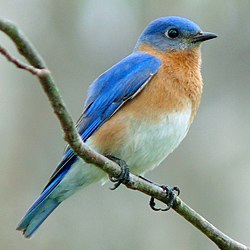Species:

Behavior
Bluebirds are territorial and prefer open grassland with scattered trees. This is similar to the behaviour of many species of woodpecker. Bluebirds can typically produce between two and four broods during the spring and summer (March through August in the Northeastern United States). Males identify potential nest sites and try to attract prospective female mates to those nesting sites with special behaviors that include singing and flapping wings, and then placing some material in a nesting box or cavity. If the female accepts the male and the nesting site, she alone builds the nest and incubates the eggs.Predators of young bluebirds in the nests can include snakes, cats and raccoons. Non-native and native bird species competing with bluebirds for nesting locations include the common starling, American crow, and house sparrow, which take over the nesting sites of bluebirds, killing young and smashing eggs and probably killing adult bluebirds.[1]
Bluebirds are attracted to platform bird feeders, filled with grubs of the darkling beetle, sold by many online bird product wholesalers as mealworms. Bluebirds will also eat raisins soaked in water. In addition, in winter bluebirds use backyard heated birdbaths.
By the 1970s, bluebird numbers had declined by estimates ranging to 70% due to unsuccessful competition with house sparrows and starlings, both introduced species, for nesting cavities, coupled with a decline in habitat. However, in late 2005 Cornell University's Laboratory of Ornithology reported bluebird sightings across the southern U.S. as part of its yearly Backyard Bird Count, a strong indication of the bluebird's return to the region. This upsurge can largely be attributed to a movement of volunteers establishing and maintaining bluebird trails.
In the garden

Of all the birds a gardener could choose to attract, the bluebird is the quintessential helpful garden bird. Gardeners go to extreme lengths to attract and keep them in the garden for their advantageous properties. Bluebirds are voracious insect consumers, quickly ridding a garden of insect pests.[2]
As a symbol in songs

Songwriters have adopted the bluebird as a symbol of happiness and cheer. Examples are Jan Peerce's signature song, "Bluebird of Happiness", "Over the Rainbow" ("Somewhere over the Rainbow/Bluebirds fly"), "I'm Always Chasing Rainbows" ("I'm Always Chasing Rainbows/Waiting to find a little bluebird in vain"), and "The White Cliffs of Dover" ("There'll be bluebirds over/The White Cliffs of Dover"). The last song, written in 1941, alludes to the hoped for end of World War II. It employs poetic license: there are no bluebirds in Europe. Songwriters have also portrayed the bluebirds as a muse, as in the song, "Voices In The Sky", from the British Rock group, The Moody Blues, from their album, "In Search of The Lost Chord". <"The Best of The Moody Blues"; information accompanying the CD>

No comments:
Post a Comment
Note: Only a member of this blog may post a comment.